Lost Trails Youth Crew Spends Five Weeks in the Pasayten Wilderness
Our Lost Trails Youth Crew made big impacts (and big memories) this summer as they improved trails in the remote Pasayten Wilderness.
This summer, a trail crew of nine teens and two leaders from across the country congregated for an extended stay in one of Washington's most remote areas — the Pasayten Wilderness.
The goal of their unusual summer job? To revitalize a series of trails that had succumbed to the realities of shrinking forest service budgets and recent wildfires. Over the course of their five-week stint, the crew cleared a path for hikers and stock to reach the deeper sections of the wilderness and access the solitude and scenery the Pasayten is known for.

A classic Pasayten view from the Cathedral Amphitheater. Photo by A. Hiker.
Located just east of the Cascade Crest and running alongside the Canadian Border, the 531,000-acre Pasayten Wilderness is home to a pretty incredible backcountry experience. You'll spot animals much harder to find elsewhere on Washington's trails — moose, lynx, wolves and bighorn sheep roam the forests and meadows. More than 150 peaks tower over the landscape, with just as many waterways weaving throughout them. More than 600 miles of trail connect hikers with all corners of the landscape. The unparalleled recreation opportunities provided by the Pasayten, combined with its inherent difficulty to maintain have made it a priority area in our Lost Trails Found campaign — our effort to save backcountry trails from falling off the map entirely.
Over the past few decades, several large fires have blazed through the area, leaving a headache for hikers and volunteers trying to navigate the Wilderness. Charred, fallen trees cover long stretches of trail — creating an obstacle course for those traveling by foot and a complete road block for those on horseback. The return of post-fire vegetation has encroached the trail corridor from all sides, making it almost impossible to discern the twists and turns of some paths. Resulting erosion also makes for an unstable trail tread for both hikers and horses alike.
With conditions like this, we knew it would take a whole lot of work to get this area back up to snuff — but we also knew that the hiking community was up to the task of getting it done.
Enter: Lost Trails Youth Crew
It can be difficult to reach the deeper sections of the wilderness with our current 5-8 day volunteer trail opportunities. Oftentimes, a hike into the Pasayten will take a full day — if not more — which limits the amount of work our volunteer crews can accomplish. By teaming up for another year with the Northwest Youth Corps and sponsoring our own Lost Trails Youth Crew, we were able to maintain a crew in the backcountry for an uninterrupted five week stay — maximizing our trail maintenance possibilities and providing a meaningful wilderness experience for our crew.
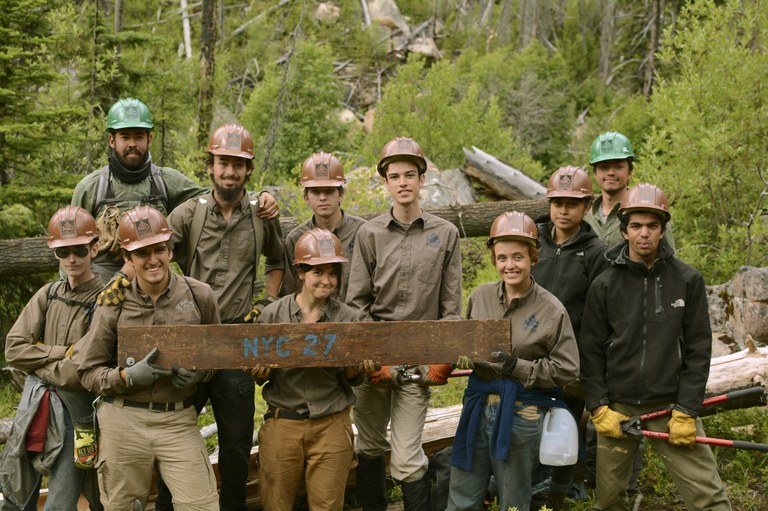
The Lost Trails Youth crew poses in front of a sheathed crosscut as they stand along a freshly brushed trail. Photo by Rachel Wendling.
Funding for this crew was made possible in part by the Spring Trust for Trails, along with additional donations by WTA supporters. Our friends at the Backcountry Horsemen of Washington were another integral asset on this project, by packing in the crew’s gear and hauling in resupplies throughout their stay.
This year, our Lost Trails Youth Crew focused on the eastern flanks of the Wilderness — covering large swaths of the Chewuch, Tungsten Creek, and Cathedral Driveway trails, as well as the Boundary Trail between Tungsten and Andrews Creek. The crew got an early jump on their season of trail maintenance — hitting the trail in mid-June and getting in front of the summer hiking season. This eased the way for an entire season's worth of hikers and volunteers on the eastern portion of the Wilderness.
During their first week, the crew set up basecamp a few miles in from the Chewuch trailhead. For many of the participants, this was their first foray into the Pasayten — and to Washington wilderness as a whole.
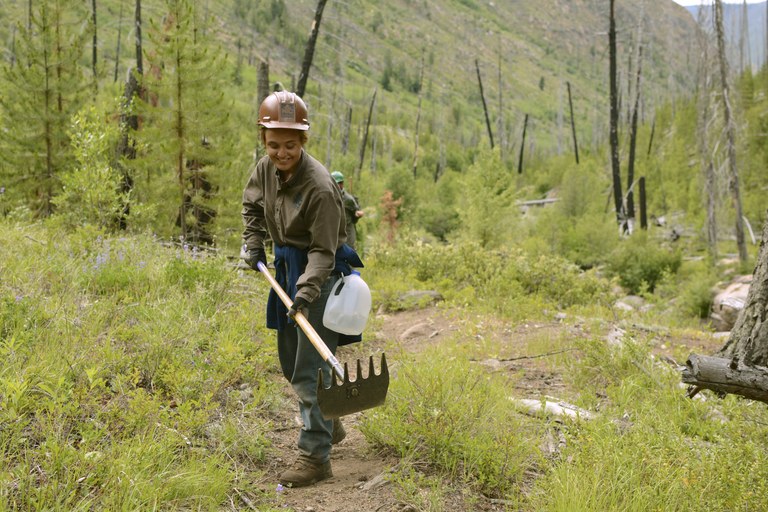
Devin spent her 19th birthday on trail with her fellow Lost Trails Youth crew members. She celebrated with a spaghetti dinner... eaten out of a hard hat. Photo by Rachel Wendling.
"Seeing these towering mountains and pine trees everywhere. It’s like nothing I’ve ever seen before," said Devin a member of the Lost Trails Crew. "The way it feels is different, the way it smells is different. Each wilderness is vastly different, and I’m very fond of this one."
Devin, a 19-year old from Illinois, has spent her last two summers working on Northwest Youth Corps crews — with the recent Pasayten crew marking her third summer. Her passion for building community and helping others access our wild places has kept her coming back to the program.
"Making these trails accessible to everyone helps preserve the bigger picture and landscape, it makes designated areas where people can venture through and enjoy everything around us, especially places like this, deserve to be accessible," she explained. "WTA works to make trails forever — I would say I think everyone deserves to see the beautiful world we live in to its greatest extent."
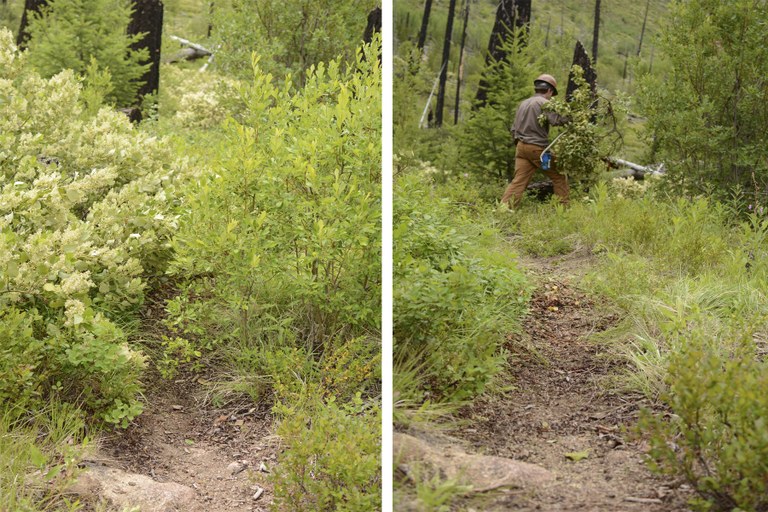
The post-fire vegetation had quickly overtaken the trail corridor and shrouded the trail from sight. This before/after shot along the Chewuch trail shows the immediate impact that brushing can make on a trail. Photos by Rachel Wendling.
After their first week, the crew had already made a noticeable improvement in accessibility. They were able to clear the Cathedral Driveway trail all the way from the trailhead to the Chewuch junction, along with the six miles between their basecamp and the Chewuch trailhead. They removed fallen trees and cut back overgrown brush. They restored and stabilized faltering tread and worked on drainage systems to help divert future rainwater off trail.
With the southern portions cleared, the crew began to focus their work north of the Fire Creek basecamp, working upstream until the junction with the Tungsten Creek trail and continuing up the Chewuch trail toward Remmel Lake. To make the most of their time (and save them a whole lot of tool-haling) the crew moved camp mid-way through their stay to a new basecamp deeper along the Tungsten Creek trail. This helped the crew shorten their daily hike in-and-out of the worksite and maintain some harder-to-reach sections of the Tungsten and Boundary trails.
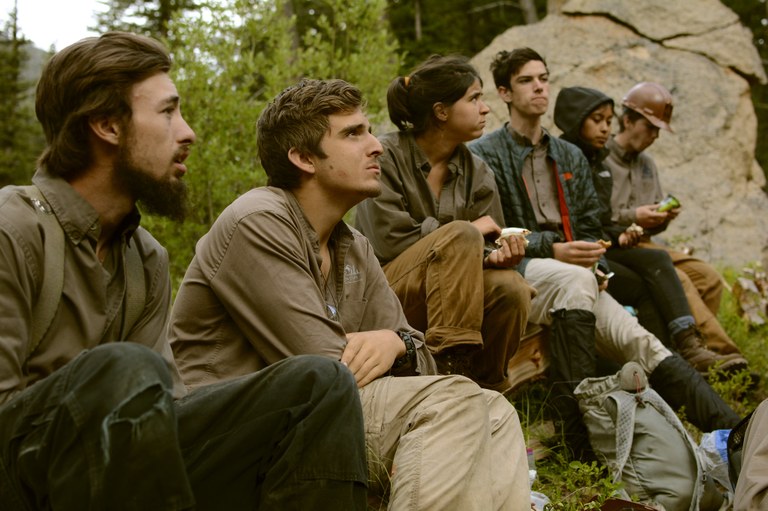
Lost Trails Youth Crew members Jackson, Elijah, Ada, Eric, Kyra and Elijah rest during a morning snack break. Photo by Rachel Wendling.
The ability to maintain a basecamp in such a remote section of the wilderness was not only beneficial for their work, but for their experience, too.
"There is a sense of peace and calm that is just unfathomable in the rush that we live in everyday life back in society," Benjamin, a crew member, mentioned about his time in the Pasayten. "It’s an inimitable experience that you can’t compare to anything. These places need to be protected and maintained so more people can have those experiences because it really is a blessing to be able to come out here."
Benjamin calls Illinois home, but has returned to the Pacific Northwest to work with on Northwest Youth Corps crews for three straight years. He loves the work, and he loves spending time outdoors — but the connections he's formed with his fellow participants have been one of the biggest drivers for returning.
"I ended up leaving with more than friends — I say that every session I left with people I can call my family. That’s what has kept me coming back, the skills I learn, the people I meet and the relationships I’ve formed which last for life."
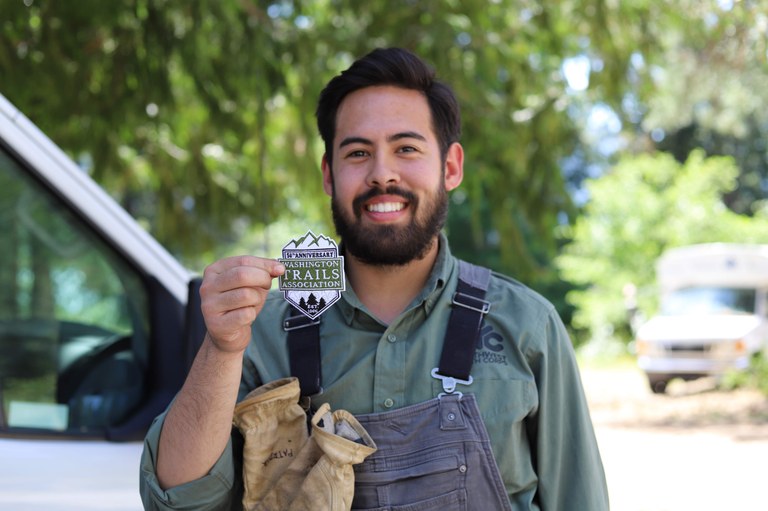
Crew Leader, Patrick, poses with a WTA patch. Photo by Edison Velez.
The upbeat and energetic crew leader, Patrick, is a local from Vancouver and a first-time Northwest Youth Corps participant this season. As a hiker and mountain biker, Patrick grew up exploring Southwest Washington with his father. His stint leading the Lost Trails Youth Crews was a whole new experience for him.
"The best part of this trip is honestly just waking up and being out here every single day," Patrick mused. "I sleep in here. I don’t have my phone glued to my face before bed and then fall asleep at 2 a.m. every night. It’s really nice to have solid sleep and to be tired — physically tired — at the end of the day. You don’t have to worry about the outside world. There are no pressures from the news or anyone. I think that’s really nice."
After five weeks together, the crew learned a lot about trail work, the Pasayten and each other. All said and done, this powerhouse crew maintained just over 32 miles of trail in the Pasayten through brushing, tread restoration and drainage work — in addition to clearing over 150 fallen trees and installing 55 new drainage structures. It's safe to say we were blown away by the amount of work these teens were able to accomplish.
We can't wait to continue our work in the Pasayten in 2020 and beyond. Thank you to all of the members, donors and volunteers who make this work possible — we couldn't do it without you!
Read more about our Lost Trails Found campaign and find out how you can help at wta.org/losttrails.


Comments